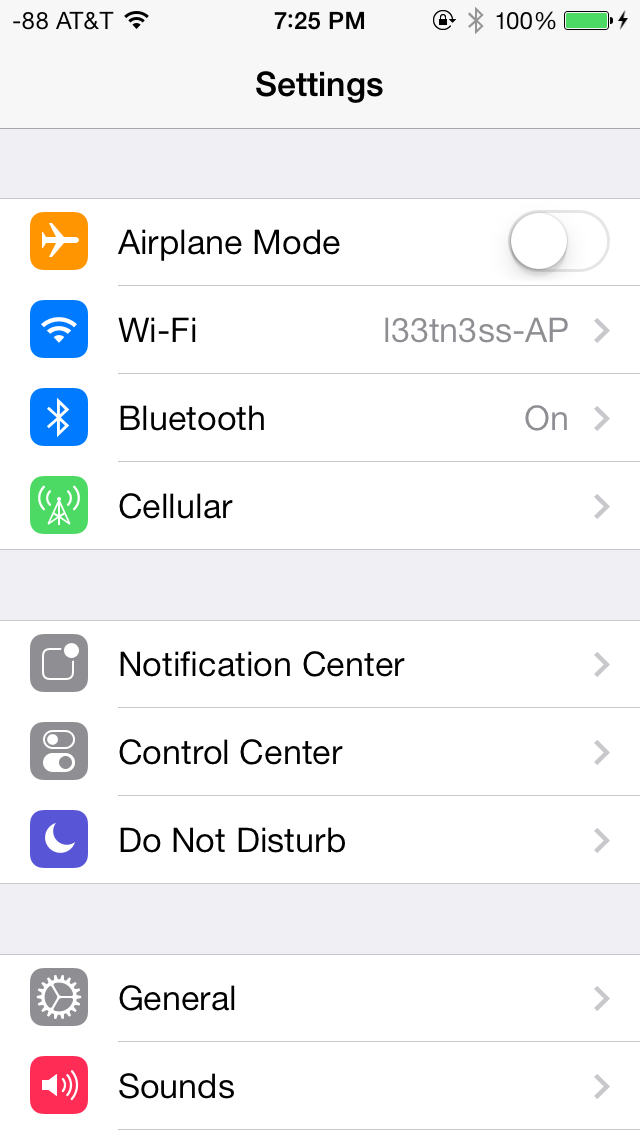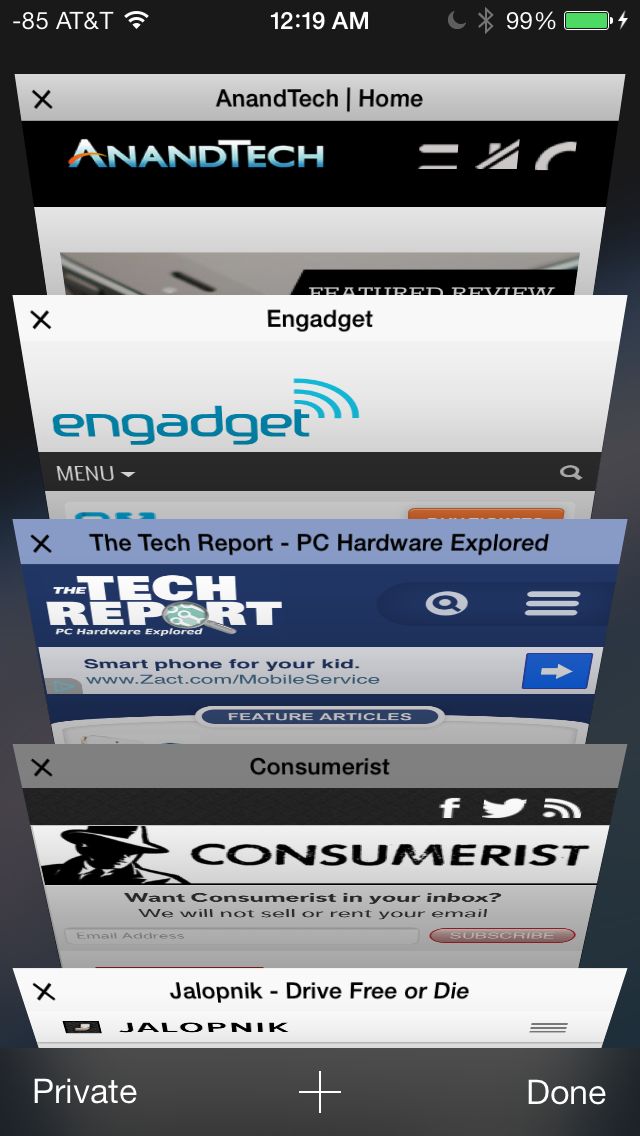The iOS 7 Review
by Brian Klug & Saumitra Bhagwat on September 19, 2013 1:25 AM ESTSettings
The changes in Settings.app are primarily visual at a high level. The application icon is perhaps the most curious change, since it looks like a sprocket for a bicycle or the gears inside a watch now, but I digress. This new UI pretty much just has visual style that matches the rest of iOS 7, and doesn’t really fundamentally change organizational structure very much. Settings are still grouped together in a couple of logical little bunches, with a bunch of third party application-specific settings options at the very bottom.
There’s obviously the addition of control center inside settings, and do not disturb comes outside of notifications. There are also the appropriate toggles for the today view under notification center. Under general and accessibility there are new options for the dynamic font size functionality, and a new toggle for disabling noise cancelation which proved somewhat controversial on the iPhone 5 (this setting also carries over to the 5s but not the 5c which I suspect lacks earpiece noise cancelation).

Safari
iOS 7 brings mobile safari version 7, which gets a huge set of functional changes and improvements to the JavaScript engine. Safari has been around for a while without many big changes to the interface, so this is big one.

There’s now a unibar at the top of the page for both URLs and search terms, this is a long overdue and welcome change that makes a ton of sense. Safari also now preloads the first result in the list while you’re typing, which has the side effect of making loading feel much faster regardless of what device you’re coming from.
The unibar also looks through bookmarks that are either synced through iCloud or exist on the iDevice and exposes those as options. It’s a bit confusing though since there are both the bookmarks under that appropriate menu, and bookmarks from the bookmarks bar that appear when you tap on the unibar on an empty tab before you start typing. I didn’t realize I even had some of those bookmarks still around until iOS 7 swung around and exposed them.
The new mobile safari gets the same transparent overlays and sense of depth that the rest of the OS conveys, the pages render below most of the UI and there’s a bit of hinting from elements that peek through. A big change is that the bottom menu now also slides away as you scroll down a page, expanding the viewport accordingly. The top bar gets smaller but retains the domain of the page being visited. Tweaks like these do help the iPhone feel bigger than it used to feel.
In addition you can now have more than 8 pages open at the same time, and safari seems a lot better at keeping tabs around and not reloading their contents every time you switch between them. The tab switching interface is also a lot better, with a card-like metaphor that allows for tabs to be quickly closed by just swiping them off the left of the display. The only slightly unnerving issue here is that the tabs aren’t antialiased during the animation and for a slight moment or two after it stops, then suddenly the edges no longer have jaggies. It’s a disconcerting subtle thing I can’t stop seeing every time I change tabs in the new mobile safari.
If the signal dots are my least favorite part of iOS, then the changes made in mobile safari and the addition of control center are my favorite.
Benchmarks
Apple usually makes improvements to its JavaScript engine (Nitro) whenever it can, and the iOS 7 mobile safari release is no exception. There’s a 15 percent difference in sunspider and browsermark, and a larger one closer to 50 percent in kraken and google octane, webxprt sees a 30 percent jump. This is comparing two iPhone 5 models running iOS 6.1.4 and the iOS 7.0 GM. HTML5 score increases as well with the addition of a few new features, and WebKit moves from 536.26 to 537.51.1.
| iOS 6.1.4 | iOS 7 GM | |
| Sunspider 1.0 (ms) | 836.6 | 721.1 |
| Browsermark 2.0 (score) | 2587 | 2998 |
| Kraken 1.1 (ms) | 20388.0 | 14050.6 |
| Google Octane (score) | 1706 | 2856 |
| WebXprt (score) | 176 | 231 |
| HTML5test.com (score) | 386+9 | 399+9 |













144 Comments
View All Comments
kwrzesien - Thursday, September 19, 2013 - link
I still don't see a way to trigger the passcode lock, am I missing some special key combination?Let's say I have a (secure) passcode set, but leave the timeout window at one or two hours. Once I'm unlocked but I know I am going to put it down / leave it in a locker / leave it on my charger at home where my kids will try to swipe it - how do I trigger the passcode lock without going through a power down cycle?
solipsism - Thursday, September 19, 2013 - link
I guess it would be nice to set it immediately without having to drill into Settings to do it but in lieu of that you should set the Passcode lock to something less than the 1 or 4 hours options.Impulses - Thursday, September 19, 2013 - link
They should implement other conditions than a simple timer... i.e. Disable the security lock or set it on a longer timer when connected to home Wifi or car Bluetooth (or any BT really since it means it's near other devices you own and are presently using) etc.; user configurable of course. Been doing that on Android thru third party apps, which they had it natively too.solipsism - Thursday, September 19, 2013 - link
I'd like to see that but I wonder if Touch ID will negate most of that sense you will be able to blindly handle the device to unlock it almost instantly.Bakes - Thursday, September 19, 2013 - link
You can set the auto-lock and passcode lock delays separately. If you set the passcode lock to immediately you can just push the physical lock/power button and the passcode will need to be entered to access the phone again. You could still leave the auto-lock delay long to keep the phone from locking itself too soon. Does this help or have I missed you point?kwrzesien - Thursday, September 19, 2013 - link
Well that is a different way of approaching it, but I'm not sure it makes it better. I tap the power button a lot to immediately turn the screen off and now I would have to rely on auto-lock for that which is 1-5 minutes.For a while I had auto-lock off and passcode at 4 hours. I want it to stay on unless I trigger it to turn off - am I a micro-managing control freak? (maybe, I enjoy Diablo and SC2 so that may explain something. btw how great would a Diablo port be to iOS!!!)
I'm just bummed that with all this new power in the control center that there isn't a "lock now" button.
uhuznaa - Thursday, September 19, 2013 - link
The longest timeout you can set for the passcode becoming active after pressing the sleep button is five minutes.LCurtisB - Thursday, September 19, 2013 - link
Actually, there are a few changes to the weather app - you can scroll left/right on the hourly forecast (and it adds things like the sunset time), and if you tap the large temperature on the top, it switches to show you Humidity, Wind, Chance o precipitation, and "feels like temperature" (for windchill/humidex).Impulses - Thursday, September 19, 2013 - link
" I feel like the old Apple would've waited until the design was perfect before letting it out, while the new Apple is acutely aware of the competition that exists and is fine shipping and updating along the way. "The old Apple also shipped a smartphone that while revolutionary it also lacked a lot of basic things that even dumb phones had at the time (copy/paste, MMS...), so let's not romanticize it. Jobs was always an advocate of doing things in a way he considered correct or not at all tho... If anything I think the unnecessarily long animations are closer to being something the old Apple might've gotten right. This thing screams performance, why bother with all that jazz...
Impulses - Thursday, September 19, 2013 - link
And by this thing I meant the 5s obviously, but it's not like the animations are helping mask anything on older devices... Just seems ill conceived.